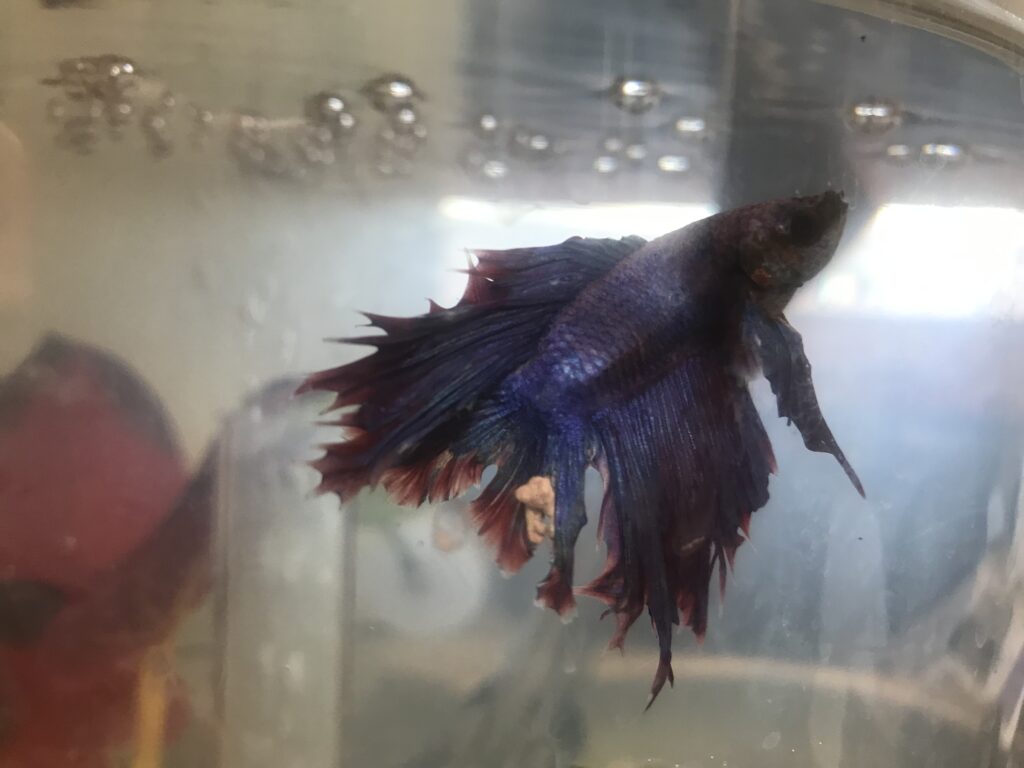Our office frequently gets calls about a betta fish with a patch of irregular skin growth or pigment. Obviously, the owner has already treated with two to three over the counter treatments with no result. Why? Well, the most common cause of white patch on betta fish is a chromatophoroma or pigment cell tumor. The white coloration is typically an iridophoroma or tumor of the iridescent pigment cells within the fish’s skin. Thankfully, this is not a life-threatening condition and will usually not effect the fish’s quality of life or life span.

What is a chromatophoroma?
A chromatophoroma is neoplasia or tumor originating from pigment cells. These can be found in any color and are most common in reptiles, amphibians and fish. They are typically isolated to the skin itself, but some more aggressive types can be found that can infiltrate or spread throughout the fish. We see these tumors fairly commonly in koi, mainly around their eyes. Most of the time, these masses are not concerning, but if they cause a change in the fish’s behavior or appetite, they will require surgical removal.

How is this white patch different from Ich?
Many owners confuse these pigment cell tumors for white spot disease, also known as Ich or Ick. Although they can present very similarly at first, white spot disease will look like your fish has been dusted with sugar or salt and will likely also have respiratory difficulty, become lethargic with changes in appetite. Chromatophoromas a typically isolated to one spot on the body and your fish will be acting relatively normal otherwise.
White spot disease is caused by a parasite, Ichthyophthirius multifiliis, with a complicated life cycle. Many over-the-counter medications will only slow down the parasite and not effectively treat it. When treating for any disease process in fish, it is critical that you take into consideration the water temperature and modify the dose correctly. Daily treatment for three to five days in a row is only going to work if your tank is above 80F/27C, which is where your betta tank should be. Since they are often kept in isolation, the chance of your betta coming down with Ich is actually quite low compared to other pet fish species.
How do you treat a white patch on betta fish?
First of all, throw out that Ich medication. Over-the-counter medications will not do anything to help this condition (or any cancer in general) and likely will just stress your fish out and make them sick in some other way. The most effective treatment for chromatophoromas is cryotherapy, or the application of liquid nitrogen, but given the betta fish’s small size, this is not an easy treatment to attempt. For larger fishes, any cryotherapy treatment must also be performed with concurrent antibiotics and pain management, which is also difficult with a very small fish.
For the most part, since these tumors do not affect the fish’s quality of life, they can be left as is and gently debrided by the fish’s environment. If they are on the distal portion of a fin, such as in the picture above, they can be surgically removed successfully. If the mass is large enough to tip the fish to one side, your veterinarian can gently remove the bulk of the white patch on betta side. For the most part, your fish will not ever notice it is there!
Prognosis for White Patch on Betta Fish
Thankfully, the prognosis of a betta fish with a white patch is very high. This type of tumor tends to be self limiting and restrict itself to the skin only. They may hinder movement depending on where they are located on the fish’s body, so additional options may be discussed with your aquatic veterinarian. Overall, the presence of a pigment cell tumor on your betta with not affect their overall life span or quality of life.

